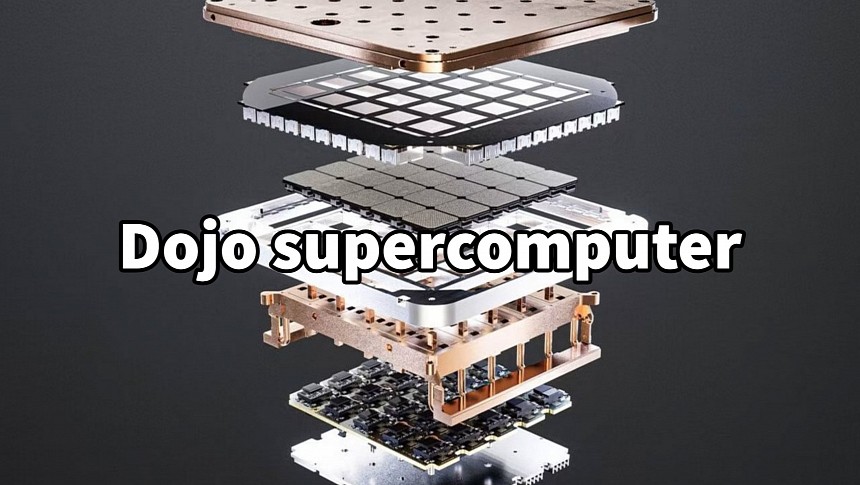Tesla AI team showed off some cool visualizations on its newly-created Twitter account, which got everybody, including Elon Musk, all pumped up. Tesla CEO explained that the Dojo supercomputer is already online and will start production training next month.
Tesla announced its Dojo supercomputer last September during AI Day, aiming to become the fifth more powerful computer in the world by next spring. By the end of 2024, the Dojo supercomputer should help Tesla reach 100 Exa-Flops, equivalent to the computing power of 300,000 Nvidia A100 Tensor GPUs. The Dojo supercomputer is the key to advancing autonomous cars and robots, as it will boost Tesla's capacity to analyze and label the enormous piles of data generated by Tesla vehicles.
Based on a new graphic by the Tesla AI team, the Dojo supercomputer will start "production" in July. This doesn't mean it will be built starting next month, but it will begin production operations. Elon Musk confirmed that Dojo has been online and "running useful tasks" for a few months, so it's almost ready to train neural networks.
Tesla's multi-modal neural networks take into account arbitrary modalities such as videos, maps, navigation, inertial measurements, GPS data, and more to predict the probability that some 3D position is occupied. This is the essence of Tesla's Occupancy Network, which can be used for collision avoidance not only by cars but also by robots.
To work efficiently, neural networks need vast amounts of data analyzed and labeled. Tesla can use video data from multiple trips in the same location to reconstruct the entire scene in a computer simulation. Tesla also uses generative modeling techniques to predict possible outcomes given past observations across multiple camera views. The Tesla AI team says these video foundation models will serve as the brain of both the car and the Optimus robot.
Elon Musk clarified that Dojo V1 is highly optimized for vast amounts of video training and would not be suitable for general-purpose AI. A second iteration of the supercomputer will address these limitations, as Tesla is now all-in in artificial intelligence. Musk hyped Tesla's achievements in this field, saying that Tesla AI is far more advanced than most experts realize, both software and hardware-wise. On the other hand, Musk also complained that Tesla needs "a crazy amount of training compute to get self-driving 10X safer than humans, but can't get enough GPUs, plus prices are extremely high!"
The Dojo supercomputer will allow Tesla to accelerate the development of Autopilot and Full Self-Driving (FSD) technologies. It could also allow the development and deployment of more sophisticated AI algorithms, increasing the safety and reliability of Tesla's autonomous driving technology. FSD beta testers should also expect faster software releases after Dojo reaches full power. Ultimately, Dojo is about more than FSD and robots, allowing Tesla to access new areas such as machine-learning research, natural language processing, and even artificial general intelligence (AGI), which is considered the holy grail of AI.
Based on a new graphic by the Tesla AI team, the Dojo supercomputer will start "production" in July. This doesn't mean it will be built starting next month, but it will begin production operations. Elon Musk confirmed that Dojo has been online and "running useful tasks" for a few months, so it's almost ready to train neural networks.
Tesla's multi-modal neural networks take into account arbitrary modalities such as videos, maps, navigation, inertial measurements, GPS data, and more to predict the probability that some 3D position is occupied. This is the essence of Tesla's Occupancy Network, which can be used for collision avoidance not only by cars but also by robots.
To work efficiently, neural networks need vast amounts of data analyzed and labeled. Tesla can use video data from multiple trips in the same location to reconstruct the entire scene in a computer simulation. Tesla also uses generative modeling techniques to predict possible outcomes given past observations across multiple camera views. The Tesla AI team says these video foundation models will serve as the brain of both the car and the Optimus robot.
Elon Musk clarified that Dojo V1 is highly optimized for vast amounts of video training and would not be suitable for general-purpose AI. A second iteration of the supercomputer will address these limitations, as Tesla is now all-in in artificial intelligence. Musk hyped Tesla's achievements in this field, saying that Tesla AI is far more advanced than most experts realize, both software and hardware-wise. On the other hand, Musk also complained that Tesla needs "a crazy amount of training compute to get self-driving 10X safer than humans, but can't get enough GPUs, plus prices are extremely high!"
The Dojo supercomputer will allow Tesla to accelerate the development of Autopilot and Full Self-Driving (FSD) technologies. It could also allow the development and deployment of more sophisticated AI algorithms, increasing the safety and reliability of Tesla's autonomous driving technology. FSD beta testers should also expect faster software releases after Dojo reaches full power. Ultimately, Dojo is about more than FSD and robots, allowing Tesla to access new areas such as machine-learning research, natural language processing, and even artificial general intelligence (AGI), which is considered the holy grail of AI.
These video foundation models will serve as the brain of both the car & Optimus robot ????????????
— Tesla AI (@Tesla_AI) June 21, 2023
Join the Tesla AI team to build the future of robotics!
→ https://t.co/dpUsVwDkge










